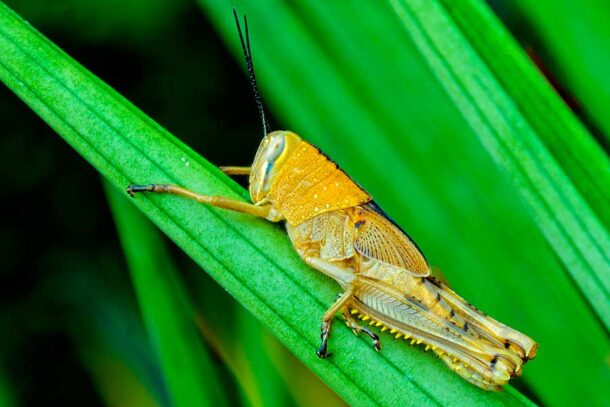Insects for Fertiliser Purposes in the Context of Animal By-products (ABP) in the EU¹
RUSTICA presents, validates and demonstrates novel products aimed at optimal plant nutrition and healthy soils. Among the value chains subject to the project, some involve insect production resulting in insect biomass and insect frass. Therefore, the question arises how to consider these subjects in the context of rules on animal by-products and fertilisers in the EU. In this regard, light is shed on some definitions relevant in this area, organic fertilisers and soil improvers, processing methods of ABP, and the legal environment of fertiliser marketing.
1. Definitions
Animal by-products² (ABP)
“‘animal by-products’ means entire bodies or parts of animals, products of animal origin or other products obtained from animals, which are not intended for human consumption, including oocytes, embryos and semen;”
Material Category 2³ : “Art. 9 (a) manure⁴, non-mineralised guano and digestive tract content;”
Material Category 3⁵ : “Art. 10 (l) aquatic and terrestrial invertebrates other than species pathogenic to humans or animals;”
Processed Proteins⁶
“‘processed animal protein’ means animal protein derived entirely from Category 3 material, which have been treated in accordance with Section 1 of Chapter II of Annex X (including blood meal and fishmeal) so as to render them suitable for direct use as feed material or for any other use in feedingstuffs, including petfood, or for use in organic fertilisers or soil improvers; however, it does not include blood products, milk, milk-based products, milk-derived products, colostrum, colostrum products, centrifuge or separator sludge, gelatine, hydrolysed proteins and dicalcium phosphate, eggs and egg-products, including eggshells, tricalcium phosphate and collagen.”
Hydrolysed Proteins⁷
“‘hydrolysed proteins’ means polypeptides, peptides and aminoacids, and mixtures thereof, obtained by the hydrolysis of animal by-products;”
Insect biomass
No specific definition could be detected on the term “insect biomass” in (EC) No 1069/2009 and its implementing Regulation (EU) No 142/2011 and their amendments.
Insect frass⁸
“‘frass’ means a mixture of excrements derived from farmed insects, the feeding substrate, parts of farmed insects, dead eggs and with a content of dead farmed insects of not more than 5 % in volume and not more than 3 % in weight.”
2. Organic fertilisers and soil improvers ⁹ ¹⁰
Placing on the market of organic fertilisers and soil improvers can be targeted if they are derived from materials of category 2 or category 3 as defined in the “Animal by-products regulation” (EC) No 1069/2009¹¹ and in accordance with all legal rules including inter alia prescribed treatments (EU No 142/2011)¹² , such as pressure sterilisation or other conditions and specific requirements (e.g., permits) on the locations conducting those treatments¹³. Separate rules are laid down if ABP are composted or used for biogas production¹⁴.
3. Processing methods ¹⁵
3.1 Insect biomass
If belonging to Material Category 3 as defined in the ABP Regulation ((EC) No 1069/2009)) two main processing routes are reflected for such materials in the ABP Regulations and reported in literature¹⁶: treatments as requested for processed proteins¹⁷ and requirements for production of hydrolysed proteins.
Treatments prescribed for processed proteins comprise inter alia plants/facilities, temperature, pressure and process duration. Depending on the process, they refer to a certain equipment (e.g. vessel). Furthermore, decisive factors for the options of treatment are, for example, size and reduction of particles. Since the origin of materials is considered as well, processing methods need to be verified in this direction. In case, fat derivatives as defined in (EU) No 142/2011¹⁸ which fall into Material Category 3 shall be marketed, the aforementioned rules also come into play¹⁹.
If hydrolysed proteins from non-ruminants are intended to be produced, ABP legislation on Material Category 3 encompasses, for example, “a production process involving appropriate measures to minimise contamination” and it needs a permit for the processing plant²⁰. Moreover, stipulations for certain organic fertilisers and soil improvers include, e.g., “materials which have been subject to another treatment” if in accordance with the ABP legislation²¹.
3.2 Insect frass
Rules of frass are aligned to those of “processed manure”²² but at time of writing its generic definition as a “manure” could not be found in EU law. But it must come from “a plant for derived products for uses outside the feed chain or from a biogas or a composting plant or from a plant for the manufacturing of organic fertilisers or soil improvement”. “It shall have been subjected to a heat treatment process of at least 70 °C for at least 60 minutes and they shall have been subjected to reduction in spore-forming bacteria and toxin formation, where they are identified as a relevant hazard. Sampling of the manure has to be conducted on compliance with defined microbiological standards. Among others, detailed stipulations (e.g. plastic bags) are made on storage to “minimise contamination, secondary infection and dampness”²³ ²⁴.
4. Fertiliser legislation
In general, marketing of fertilisers in the EU can be conducted via the harmonised scheme of the EU Fertilising Products Regulation or under a non-harmonised national/regional legal regime in an EU country or both.
4.1 Marketing by harmonised rules of the Fertilising Products Regulation (EU) 2019/1009 (FPR)
To date, Annex II, CMC 10 DERIVED PRODUCTS WITHIN THE MEANING OF REGULATION (EC) NO 1069/2009 of the FPR²⁵ indicates a “Table” which is not completed. The “endpoints in the manufacturing chain” as referred to in the Animal By-Products Regulation²⁶ ²⁷ ²⁸ and requested for ABP/derived products in the FPR are under elaboration.
If ABP/derived products are composted (CMC 3) or digested by AD (CMC 5) in the course of the FPR, specific rules apply to inputs and the amended version of the FPR refers to the requirement of “endpoints in the manufacturing chain” as well²⁹.
As such, rules are currently under work and progress if ABP/derived products should be marketed as a CE-marked fertiliser by the new FPR. Suggestions on these materials to be included into the FPR³⁰ are made, and e.g., an option to tackle the issue of “endpoints” by submitting a dossier by an applicant to a national authority is recommended by guidelines of ECOFI³¹. ESPP discusses, for instance, some modifications on “endpoints” relating to CMCs in the FPR³².
4.2 Marketing by non-harmonised national/regional rules – Aspects of RUSTICA test case regions
If in compliance with all legal requirements³³, rules relating to insects and frass under a national legal regime on fertilisers are enabled. “Processed proteins” and “hydrolysed proteins” may be taken into account for fertilising products addressed by national/regional rules in an EU country. Member States are committed to adapt their national rules on the processing of frass according to the abovementioned Regulation (EU) 2021/1925³⁴.
Currently, some information can be found particularly dedicated to insects in national/regional fertiliser law while Flanders has published regional rules on frass³⁵. A market authorisation is reported on frass in France in the context of organic farming³⁶. Projects on insect materials and ABP treatments are highlighted for Italy³⁷ and norms for organic production exist in Spain³⁸.
¹ Placing on the market, but rules different to this information may apply to exports, imports, transit, specific treatments (e.g., composting and anaerobic digestion) and organic farming. Separate rules apply to research as well. ² Art. 3 (EC) No 1069/2009; https://eur-lex.europa.eu/legal-content/EN/TXT/?uri=CELEX%3A02009R1069-20191214 (retr. 24.01.2024) ³ List of Category 2 Materials in Art. 9 (EC) No 1069/2009 ⁴ To date, there is no explicit definition of “processed manure” in Art. 9 of (EC) No 1069/2009. ⁵ List of Category 3 Materials in Art. 10 (EC) No 1069/2009 ⁶ Annex I (5.) of (EU) No 142/2011; https://publications.europa.eu/resource/cellar/cd9d61df-9a87-11ee-b164-01aa75ed71a1.0006.03/DOC_1 (retr.24.01.2024) ⁷ Annex I (14.) of (EU) No 142/2011 ⁸ Annex (1.) of (EU) 2021/1925; https://eur-lex.europa.eu/legal-content/EN/TXT/?uri=CELEX:32021R1925 (retr. 24.01.2024) ⁹ Art. 32 (EC) No 1069/2009 refers just to organic fertilisers or soil improvers. No other fertilising products are mentioned. ¹⁰ Art. 30 of (EC) No 1069/2009 rules on common application of organic fertilisers and soil improvers in Member States (Art. 22 (5) of (EU) No 142/2011) ¹¹ and its amendments ¹² and its amendments ¹³ Among others: Art. 3, 15 and 32 (EC) No 1069/2009; (EU) No 142/2011 including amendments ¹⁴ Among others: Art. 3,15 and 32 of (EC) No 1069/2009; Art. 10, Art. 22, Annex V and VI of (EU) No 142/2011 (not detailed here in this document) ¹⁵ If intended for use as organic fertiliser or soil improver, but different rules may apply if composted or treated in a biogas plant. ¹⁶ In this publication, the term “literature” encompasses “peer-reviewed” and “grey” literature, as well as web-publications. ¹⁷ Annex IV of (EU) No 142/2011 includes seven processing methods which need to be thoroughly studied. ¹⁸ and its amendments ¹⁹ IPIFF Guide on Good Hygiene Practices for European Union (EU) producers of insects as food and feed November 2022 https://ipiff.org/wp-content/uploads/2019/12/IPIFF-Guide-on-Good-Hygiene-Practices.pdf (retr. 01.02.24) ²⁰ Art. 24 of (EC) No 1069/2009 ²¹ Annex XI (Chapter II, Section 1) of (EU) No 142/2011 ²² IPIFF; https://ipiff.org/wp-content/uploads/2021/11/Nov-29-202 1-IPIFF-fact-sheet-on-insect-frass-final.pdf (retr. 01.02.2024) ²³ Annex XI (Chapter I, Section 2) of (EU No 142/2011) (consolidated version – information by Amendment (EU) 2021/1925) ²⁴ IPIFF; https://ipiff.org/insects-frass/ (retr. 23.01.2024) ²⁵ (EU) 2019/1009; https://eur-lex.europa.eu/legal-content/EN/TXT/?uri=CELEX%3A02019R1009-20221003 (consolidated version) (retr. 23.01.2024) ²⁶ Art. 5 of (EC) No 1069/2009 ²⁷ RUSTICA D3.2, Table 16 on page 64 shows the list with derived products with a defined endpoint of the manufacturing chain (2021) https://rusticaproject.eu/wp-content/uploads/2023/03/D3.2_RUSTICA-valorisation-concepts-EU-legislative-framework.pdf (retr. 01.02.2024) ²⁸ To date, the list neither indicates rules on insect biomass nor on insect frass. ²⁹ European Commission, Regulation (EU) 2019/1009 – the Fertilising Products Regulation Frequently Asked Questions (Qu. 8.26 on page 40) https://ec.europa.eu/docsroom/documents/54694 – last update 05/06/2023 (retr. 28.01.2024) ³⁰ EBIC-ECOFI; https://biostimulants.eu/wp-content/uploads/2021/03/20210308-EBIC-ECOFI-Joint-position-ABPs-endpoints-v5-final.pdf (22.01.2024) ³¹ ECOFI; https://storage.ning.com/topology/rest/1.0/file/get/8672980499?profile=original (retr. 22.01.2024) ³² ESPP (European Sustainable Phosphorous Platform) https://www.phosphorusplatform.eu/images/download/ESPP%20input%20FEG%20ABPs%208_12_22.pdf (retr. 01.02.2024) ³³ All of the EU and national stipulations ³⁴ (EU) 2021/1925; https://eur-lex.europa.eu/legal-content/EN/TXT/?uri=CELEX:32021R1925 (retr. 24.01.2024) ³⁵ Vlaanderen; Department Landbow and Visserji; Insecten; Strategisch Platform Insecten, https://lv.vlaanderen.be/nl/dier/paarden-ezels-bijen-honden/insecten# (retr. 01.02.2024) ³⁶ ANSES, 2021; https://www.anses.fr/fr/system/files/phyto/decisions/YNFRASS_FODG_2020-3577_D.pdf ³⁷ BioEcoFlies. (2022). GOI 2017: BIOECO_FLIES Valorizzazione di sottoprodotti di filiere vegetali tramite insetti: nuove soluzioni per impieghi alimentari, agronomici ed energetici. https://progetti.crpv.it/Home/ProjectDetail/28 (retr. 20.01.2024) ³⁸ NORMA UNE 142500 : 2017 https://www.mapa.gob.es/es/alimentacion/temas/produccion-eco/une1425002017insumosfertilizantesenmiendasysustratosdecultivo_tcm30-452234.pdf (retr. 01.02.2024)
01.02.2024
Adelheid Wiedemann
Wiedemann GmbH, Germany
www.wiedemann-gmbh.eu
Disclaimer: The views presented in this document are solely an opinion of the author. The author and the RUSTICA consortium members do not accept any liability for direct or indirect consequences, losses or damages resulting from the use of this document, its content or parts of it. This document is exclusively prepared for general information purposes and represents in no kind a legal or any other advice.


